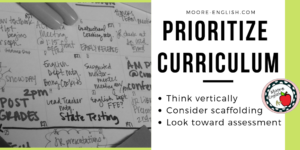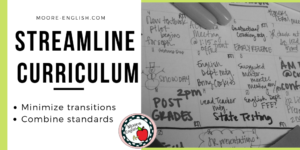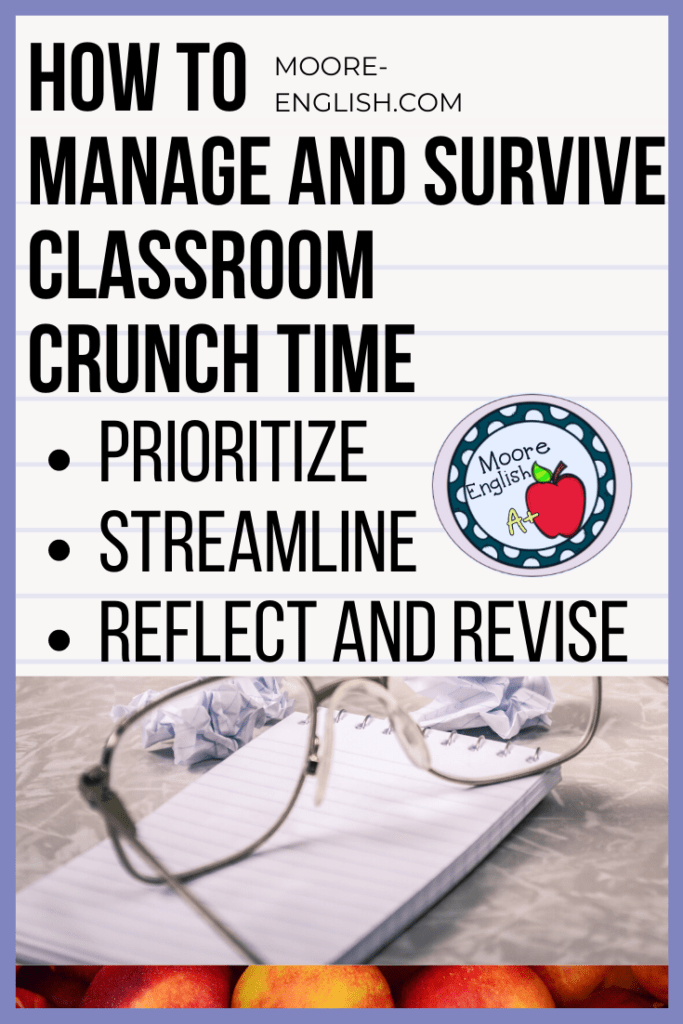We’re getting to the time of the year when the calendar starts to condense and compress. It’s the classroom crunch! Suddenly, it’s a week until Thanksgiving break, tomorrow is probably a snow day, and you’re wondering where the time has gone. Things are starting to look grim. You have too much curriculum and not enough days left on the calendar. We’ve all been there. And here are some tips for getting through the year-end crunch.

This post this post may contain affiliate links. Please read the Terms of Use.
Prioritize to Survive the Crunch
Prioritize. What knowledge and skills do students absolutely need when they leave your classroom? While all standards are important, they are not created equal. Which standards are non-negotiable for you and your students? Once you can answer these questions, you will be on the path to surviving crunch time. In order to answer these questions:
Think Vertically: Where are your students going next? I teach sophomore and junior English. So when it comes time to prioritize, I start to think about what skills and content students absolutely must have before moving on to English 11 or 12. For example, in order to be successful in junior English, my sophomores must know how to locate, embed, and cite evidence. With this in mind, activities and lessons that stress CCSS RL 9-10.1 about drawing conclusions and making inferences becomes a priority. And SL 9-10.1b about working with peers to establish discussion norms gets less screen time.
Consider Scaffolding: In addition to skills and content students need to know before they leave, what content should they learn in your class as scaffolding for learning in future classes? For example, students learn about independent and dependent clauses and parts of speech in ninth grade so they can work on active voice in tenth grade and gerunds in eleventh. So it would be in students’ best interest to continue emphasizing language standards.
Look Toward Assessment. At the end of the semester, how will students be assessed? While I don’t want to encourage you to teach purely to the test, backwards design is sound practice. It would be unfair to send students toward a team, district, or state assessment without adequate preparation. For example, our sophomore state assessment always includes context clues. So I will continue to prioritize context clues. Similarly, the state assessment has no listening component. For this reason, I will emphasize context clues with every reading and grammar lesson but maybe will only stress listening once a week.

Streamline to Survive the Crunch
Streamline. In addition to prioritizing as you move forward, also plan your remaining class time so as to be as efficient as possible. Make the most of what class time you have left.
Minimize Transitions: Tomorrow, time every transition in your classroom. How much time does it take students to settle into the bell ringer? How much time does it take students to move from the bell ringer into the first part of the lesson? And how much time do students lose moving from paper-pencil activities to digital work? You will be amazed at how much class time we spend transitioning.
- In order to minimize these transitions, we can learn a lot from our elementary friends: use timers, try a doorbell for classroom transitions, or try classroom signals. One of my mid-year classroom resolutions is going to be trying out a classroom signal.
- Look for other opportunities to maximize class time. For example, when students pass in work, always have them pass backward instead of forwards. Always make sure to have routines and procedures for students to fall back on. I also assign some classroom jobs to students. Even my high-school students feel empowered by some of the smallest responsibilities: answering the door, advancing the PowerPoint, or changing the daily analogy.
Combine Standards: Especially in ELA, our standards overlap, so design lessons and learning opportunities that ask students to work across standards. For example, even the simplest writing assignments probably touch multiple standards.
Today, my sophomores summarized a scene from Julius Caesar. While summary was the lesson priority (RL 9-10.2), students also had to make inferences (RL 9-10.1), use context clues to determine the meaning of unknown words (L 9-10.4), write appropriately for audience and purpose (W 9-10.4) and use an appropriate tone and style (L 9-10.3).
In one small assignment, students touched on five standards. If I ask them to type their response, we touch another standard (W 9-10.6). If I ask them to provide feedback to one another, that’s another standard (W 9-10.5). And if we share summaries aloud, that’s yet another standard (SL 9-10.4). This means that lesson design can be a natural way to ease the end-of-the-semester crunch. Not only do teachers want their classrooms to be efficient, but we also want lessons that make the most of student skill and seat time.

Follow the Crunch with Reflection
Revise and Reflect: Regardless of how much prioritizing and streamlining I do in my classroom, crunch time is a struggle. Each year it looks a little different. For example, we’re doing a textbook pilot this year. And the time commitment was far more than anticipated.
Next year, we’ll be learning a new textbook and a revised curriculum. So I’m sure that will cause a strain. Regardless of what causes crunch time, I want to avoid making the same missteps twice. For example, after my first year of teaching, I learned not to schedule two major process papers in one semester.
Revising and reflecting on factors that caused me to feel pressed for time is a valuable way to help me plan for the future. Similarly, if I make note of how well I reacted to feeling crunched for time, I can learn which reactions produced the greatest benefit for my students.
Reflection does not have to be elaborate. Sometimes a note in my plans or a Google Keep note is enough of a reminder. When I arrive at this point in the semester next year, I have an even better way to help my students. From my reflection, I know how to revise my practice going forward. This is part of the process of growing professionally and being a lifelong learner.
How do you handle the classroom crunch? Share your best tips and tricks in the comments!

Photo by Uday Mittal, Julien L, Alexander Krivitskiy, and Theo Crazzolara on Unsplash
















